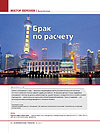Aerospace Defense System is Able to Withstand Air and Space Means of Destruction
A little more than a year has passed since the appointment of Yan Valentinovitch Novikov as the CEO of one of the world’s largest defense companies — OJSC “Concern PVO “Almaz-Antey”. In this period by the decision of the Russian Federation President the group receives a new name — OJSC “Concern VKO “Almaz-Antey” — and, therefore, a wider field of responsibility. It happened so that at about the same time the US and the European Union imposed sanctions against Russian companies, including “Almaz-Antey”. Chairman of the Board, General Director of Concern VKO “Almaz-Antey” Yan V. Novikov told “Economic Strategies” magazine about successful implementation of the objective of creating aerospace technology in the current geopolitical environment.












